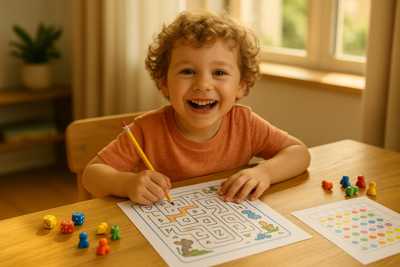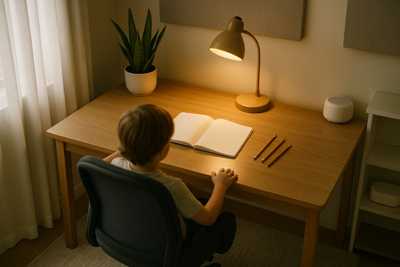Building Reading Confidence Through Multisensory Activities That Actually Work
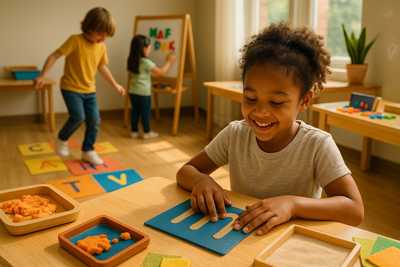
Image made with AI (DALL-E)
Discover research-backed hands-on reading techniques using touch, sound, and movement to strengthen literacy skills and build confidence in struggling readers.
You know what's less fun than watching paint dry? Watching a kid struggle through reading practice while their confidence slowly evaporates like that paint. I've been there—watching those little shoulders slump, the heavy sighs, the sudden "I need to use the bathroom" escapes. It's heartbreaking.
Here's the thing though: traditional "sit still and sound it out" approaches work great for some kids. But for others? It's like trying to learn guitar by staring at sheet music without ever touching the strings. That's where multisensory reading activities swoop in like the educational superhero we didn't know we needed.
These aren't just fancy buzzwords that educators throw around at conferences (though we absolutely do that). Multisensory reading activities engage visual, auditory, kinesthetic, and tactile pathways simultaneously, creating multiple neural highways to the same destination: reading success. Think of it as giving your brain several GPS routes instead of just one—way harder to get lost that way.
What Are Multisensory Reading Activities, Really?
Let's cut through the jargon for a second.
Multisensory reading means engaging multiple senses at once when teaching literacy skills. Instead of just looking at letters on a page (visual only), you're combining sight with touch, sound, and movement. You might trace sandpaper letters while saying the sound out loud, or jump on letter mats while sounding out words.
The science behind this is actually pretty cool. When you activate multiple brain regions simultaneously, you're creating stronger memory encoding for letter recognition and phonemic awareness. It's like studying for a test while eating a specific snack, listening to particular music, AND sitting in a certain spot—suddenly you've got multiple memory triggers instead of just one.
Why This Matters for Struggling Readers
Research shows that multisensory approaches are particularly effective for dyslexic learners and kids with reading difficulties. That's not coincidence—it's neuroscience.
The Orton-Gillingham method, which combines visual, auditory, and kinesthetic elements, has been the gold standard for structured literacy intervention since the 1930s. (Yes, we've known this works for nearly a century. Sometimes education moves slower than continental drift.)
Here's what happens: when a child traces a letter in sand while simultaneously saying its sound, they're building multiple associations. If the visual memory fails them later, the muscle memory or auditory memory might kick in. It's redundancy in the best possible way.
Why Reading Confidence Matters More Than You Think
Let me paint you a picture that's probably familiar.
A child stumbles through reading once, gets corrected. Stumbles again, gets more corrections. Pretty soon, they've decided they're "bad at reading"—and boom, you've got a self-fulfilling prophecy on your hands. They avoid reading, get less practice, fall further behind, and the confidence death spiral continues.
Building reading confidence isn't touchy-feely nonsense—it's mission-critical. Confident readers take risks, attempt new words, and practice more. That practice leads to improvement, which feeds confidence. It's the virtuous cycle we're all chasing.
Multisensory activities build confidence because they offer immediate, tangible success. Tracing a letter correctly? Win. Jumping on the right sound? Another win. These micro-successes accumulate faster than with traditional methods.
Real Talk: Schools implementing movement-based reading programs report 15-20% improvement in reading comprehension scores. That's not magic—that's giving kids multiple ways to succeed.
Hands-On Tactile Reading Techniques
Alright, let's get practical. Here are tactile learning approaches that actually work without requiring a Pinterest-worthy craft budget.
Sandpaper Letters and Texture Tracing
This is old-school Montessori wisdom that holds up. Get sandpaper letters (or make them with sandpaper and cardboard—we're teachers, not Rockefellers). Have kids trace the letter with their fingers while saying the sound.
The rough texture provides sensory feedback that smooth paper doesn't. Sandpaper letter tracing combined with verbal sound repetition shows measurable improvement in letter recognition within 4-6 weeks for struggling readers.
Other texture options: - Finger painting letters while saying sounds - Playdough letter formation (squish and learn!) - Writing in shaving cream on a table (bonus: instant cleanup motivation) - Salt or sand trays for letter practice
Tactile Phonics Activities
Try having kids manipulate physical objects while learning phonics patterns. Use magnetic letters to build words, move letter tiles, or arrange foam letters in word families.
The physical act of moving letters to create words engages kinesthetic memory. Plus, kids can physically "see" and "feel" how changing one letter changes the whole word—a concept that's abstract on paper becomes concrete with manipulation.
Sound and Movement Reading Exercises
Let's talk about getting loud and getting moving (music to every kid's ears, nightmare to every upstairs neighbor).
Auditory Reinforcement Techniques
Pair every written letter with its sound—consistently and repeatedly. But make it interesting:
- Sound songs and chants that connect phonemes to rhythm
- Echo reading where kids repeat what they hear
- Tapping out syllables while saying words
- Recording themselves reading and playing it back
The auditory component is crucial for phonemic awareness. Some kids need to hear the sounds explicitly broken down way more than visual learners do.
Kinesthetic Reading Activities for Children
This is where we separate the "sit still and be quiet" traditionalists from the "let's jump around" progressives. (Spoiler: the jumping works.)
Movement-based literacy activities improve phonological awareness, decoding skills, and reading fluency through whole-body engagement. Here's how:
- Letter hopscotch: Draw letters in chalk, call out sounds, kids jump to the correct letter
- Word building relay races: Run to grab letter cards and build words
- Sky writing: Use whole arms to "write" letters in the air
- Walking while reading: Simple but effective for some learners
Think of movement as another sensory input channel. For kinesthetic learners especially, asking them to sit perfectly still while learning is like asking you to learn something important while standing on one leg—possible, but why make it harder?
How to Implement Multisensory Reading Activities (The Practical Part)
Okay, enough theory. Let's build your actual game plan.
Step 1: Assess Current Reading Level
Before you start finger-painting letters everywhere, figure out where the gaps are. Use phonemic awareness screeners, letter recognition assessments, or simple decoding tests. You need to know what you're targeting.
Step 2: Choose Your Sensory Modalities Wisely
Not every kid responds the same way. Some might love tactile activities but find auditory stuff distracting. Others need movement or they'll vibrate out of their seats anyway.
Try different multisensory techniques and watch what engages each learner. Then double down on what works.
Step 3: Combine Phonics with Multisensory Engagement
Here's the critical part: multisensory activities should complement, not replace, structured phonics instruction. You're not choosing between systematic literacy instruction and fun activities—you're combining them.
Introduce the phoneme systematically (the "science of reading" part), then reinforce it through multisensory practice (the "making it stick" part).
Step 4: Practice in Short, Focused Sessions
Daily 10-15 minute multisensory sessions beat one hour-long marathon every week. Consistency creates neural pathways; marathon sessions just create exhaustion.
Give immediate feedback. Celebrate successes. Make it feel like play, not work.
Step 5: Track Progress and Adjust
Use informal observations and formal assessments to monitor improvement. Are letter recognition scores improving? Is decoding fluency increasing? Is the kid more willing to attempt reading?
If progress stalls, switch up your multisensory techniques. What worked last month might need refreshing.
Pro Tip: Many teachers worry about "over-stimulating" with too many sensory inputs. Valid concern! Start with one or two modalities combined, then add others if needed. More isn't always better.
Common Mistakes to Avoid (Learn from Our Failures)
Let's talk about what not to do, because sometimes that's more valuable.
Mistake #1: Treating Multisensory as the Whole Program
Multisensory reading strategies for dyslexic learners and struggling readers are powerful—but they're supplements to structured literacy, not replacements. You still need systematic phonics instruction as your foundation.
Mistake #2: Sensory Overload
I once watched a well-meaning teacher have kids trace letters in sand while singing while jumping. It was... chaos. Pick 2-3 sensory channels, not all five at once.
Mistake #3: Ignoring Individual Learning Profiles
Some kids genuinely hate getting their hands messy. Others find auditory input overwhelming. Respect individual sensory preferences while encouraging gentle expansion of their comfort zones.
Frequently Asked Questions
What age groups benefit most from multisensory reading activities?
While effective across ages, multisensory approaches show the greatest impact for K-2 emergent readers and struggling readers at any age. Here's the beautiful part: it's particularly beneficial for dyslexic learners of all ages, even adults learning to read.
The methods scale up or down based on developmental level. Preschoolers might trace giant letters in sand; middle schoolers might use textured letters for morphology study.
Can multisensory activities replace traditional phonics instruction?
Hard no. Multisensory activities enhance and reinforce structured phonics programs—they don't replace them. Think of phonics as the recipe and multisensory techniques as the cooking methods that make the recipe work better.
You need both the systematic "what to teach" (structured phonics scope and sequence) and the engaging "how to teach it" (multisensory techniques).
What materials are needed for hands-on reading techniques?
Good news: you don't need expensive commercial kits. Sandpaper, playdough, textured surfaces, finger paints, and common household items work beautifully. Salt trays cost about $2. Shaving cream is already in your bathroom.
That said, commercial multisensory programs exist if you want pre-made materials. But creativity and a dollar store will get you most of what you need.
How do I know if these strategies are working?
Track measurable progress through phonemic awareness screeners, letter recognition fluency tests, decoding assessments, and reading comprehension scores over 4-8 weeks. Also watch for softer indicators: increased willingness to read, fewer "bathroom breaks" during reading time, more volunteering to read aloud.
If you're seeing improvement in engagement but not scores, keep going—confidence often improves before scores do. If you're seeing neither after 6-8 weeks, reassess your approach.
Which multisensory approaches work best for dyslexia?
The Orton-Gillingham approach and its derivatives (Wilson Reading System, Barton Reading, etc.) specifically target dyslexia with structured, sequential, multisensory methods. These combine systematic phonics with simultaneous visual, auditory, and kinesthetic-tactile inputs.
Texture-based letter learning, skywriting, and tapping out sounds while reading are particularly effective dyslexia-friendly reading strategies because they provide the redundancy and explicit instruction dyslexic brains need.
Wrapping This Up (With a Bow Made of Sandpaper Letters)
Here's the truth: building reading confidence through multisensory activities isn't a magic bullet. It won't transform a struggling reader into a bookworm overnight, and anyone who promises that is selling something.
But what it will do is provide multiple pathways to success, engage learners who check out during traditional instruction, and build the small wins that accumulate into genuine confidence.
The key takeaways?
- Combine senses strategically—touch, sound, and movement create stronger memory encoding than vision alone
- Keep it systematic—multisensory techniques enhance structured literacy programs, they don't replace them
- Track what works—individual learners respond differently; adjust your approach based on actual progress
- Be consistent—short daily sessions beat occasional long ones every time
Start small. Pick one tactile activity and one movement-based technique. Try them for two weeks. Watch what happens to both skill development and confidence. Then build from there.
Because at the end of the day, we're not just teaching kids to decode words—we're helping them believe they can decode words. And that belief? That's where the real reading magic happens.
Now go forth and let those kids trace some letters in shaving cream. Your inner neat freak will survive. Their reading confidence might just thrive.
Links marked with an asterisk (*) are affiliate links to external offers. If you click on such a link and make a purchase through it, we receive a commission from the provider. The price does not change for you.
Related Articles

From Frustration to Fun - Turning Writing Practice Into Play
Discover game-based writing exercises that transform reluctant writers into eage...
9 min read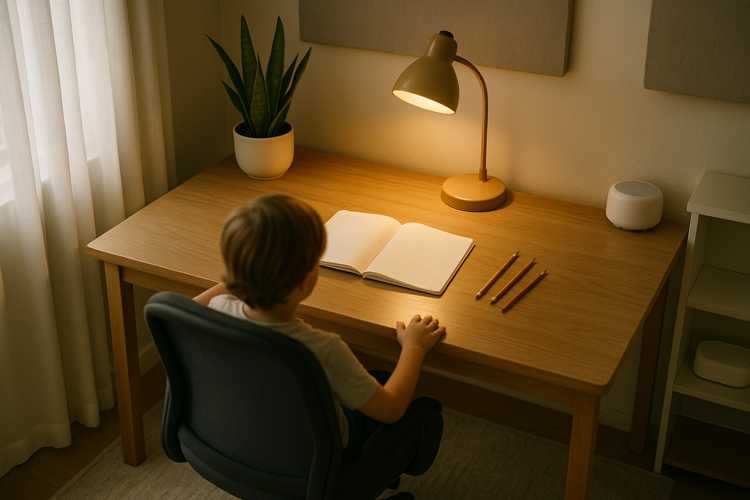
Creating a Calm Learning Space at Home - A Parent's Guide to Better Focus
Discover how lighting, sound, temperature, and texture impact your child's focus...
13 min read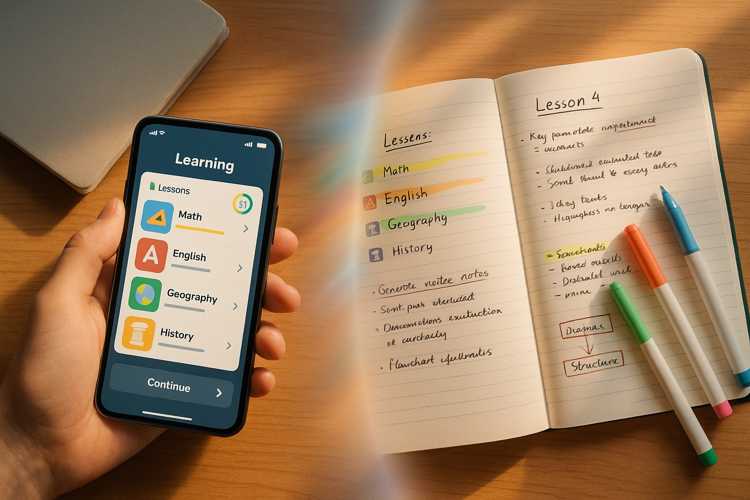
Bridging Apps and Offline Learning - Making Tech Work for You
Discover how combining educational apps with physical workbooks boosts retention...
8 min read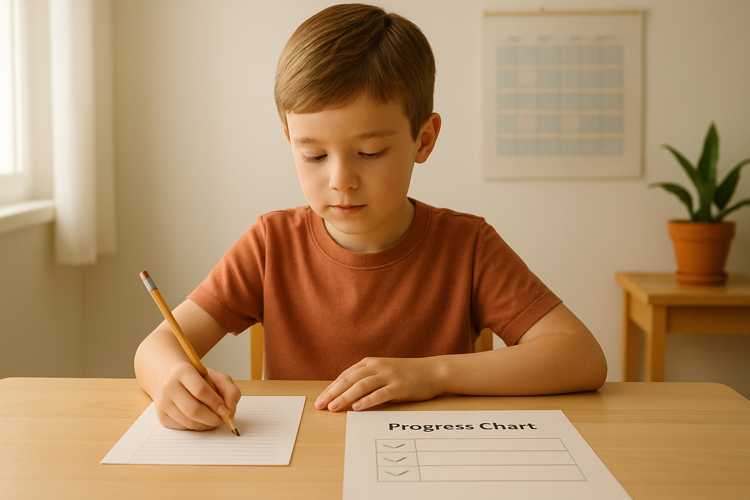
Why Consistency Beats Complexity in Teaching Basic Skills (Especially for Neurodivergent Learners)
Discover how structured repetition and daily routines help neurodivergent learne...
11 min read